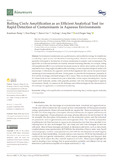JavaScript is disabled for your browser. Some features of this site may not work without it.
| dc.contributor.author | Zhang, Kuankuan | |
| dc.contributor.author | Zhang, Hua | |
| dc.contributor.author | Cao, Haorui | |
| dc.contributor.author | Jiang, Yu | |
| dc.contributor.author | Mao, Kang | |
| dc.contributor.author | Yang, Zhugen | |
| dc.date.accessioned | 2021-10-07T13:30:35Z | |
| dc.date.available | 2021-10-07T13:30:35Z | |
| dc.date.issued | 2021-09-23 | |
| dc.identifier.citation | Zhang K, Zhang H, Cao H, et al., (2021) Rolling circle amplification as an efficient analytical tool for rapid detection of contaminants in aqueous environments. Biosensors, Volume 11, Issue 10, Article number 352 | en_UK |
| dc.identifier.issn | 2079-6374 | |
| dc.identifier.uri | https://doi.org/10.3390/bios11100352 | |
| dc.identifier.uri | http://dspace.lib.cranfield.ac.uk/handle/1826/17149 | |
| dc.description.abstract | Environmental contaminants are a global concern, and an effective strategy for remediation is to develop a rapid, on-site, and affordable monitoring method. However, this remains challenging, especially with regard to the detection of various contaminants in complex water environments. The application of molecular methods has recently attracted increasing attention; for example, rolling circle amplification (RCA) is an isothermal enzymatic process in which a short nucleic acid primer is amplified to form a long single-stranded nucleic acid using a circular template and special nucleic acid polymerases. Furthermore, this approach can be further engineered into a device for point-of-need monitoring of environmental pollutants. In this paper, we describe the fundamental principles of RCA and the advantages and disadvantages of RCA assays. Then, we discuss the recently developed RCA-based tools for environmental analysis to determine various targets, including heavy metals, organic small molecules, nucleic acids, peptides, proteins, and even microorganisms in aqueous environments. Finally, we summarize the challenges and outline strategies for the advancement of this technique for application in contaminant monitoring. | en_UK |
| dc.language.iso | en | en_UK |
| dc.publisher | MDPI | en_UK |
| dc.rights | Attribution 4.0 International | * |
| dc.rights.uri | http://creativecommons.org/licenses/by/4.0/ | * |
| dc.subject | rolling circle amplification | en_UK |
| dc.subject | environmental monitoring | en_UK |
| dc.subject | heavy metals | en_UK |
| dc.subject | organic molecules | en_UK |
| dc.subject | microorganisms | en_UK |
| dc.title | Rolling circle amplification as an efficient analytical tool for rapid detection of contaminants in aqueous environments | en_UK |
| dc.type | Article | en_UK |
Files in this item
The following license files are associated with this item:
This item appears in the following Collection(s)
-
Staff publications (SWEE) [2827]

